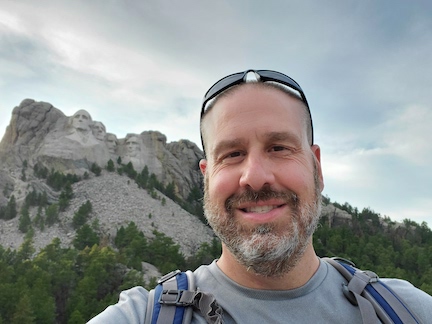
Erik Taipalus is a project manager at the UM-Flint ITS. He has more than 20 years of experience in the technology space, and focuses on listening to what people are asking for, and then finding or designing and implementing creative solutions.
How did you get into this type of work?
My family owned a construction company, and I worked for my dad from ages 16 to 21. I thought my career would be in construction. It’s a creative field, which I loved, but I didn’t really enjoy the type of work as much. In 1994, my dad bought computers for everyone in the business, and tasked me with getting them all set up. It got me really excited about technology, about moving the business from analog to digital. About 90% of our work was now computerized, and that made things easier, more streamlined.
What do you enjoy most about your job?
I really enjoy working with people, especially helping them connect with technology to meet a need and produce a real benefit for them. It’s not just technology for the sake of technology, or whatever’s flashy or exciting. It’s about finding the actual, proper fit. I’ve talked to a lot of people who work in the technology field for a long time and they still love it, and are excited by the new innovations that come out every year.
How does your work impact the university?
It is important to be a good steward of resources because every dollar is precious. I try to create tried and true solutions that will meet customer goals while being very careful about how money is spent. My goal is to maximize value and gain for customers, and help shape customer plans for the future. This is where my skills as a project manager come in handy. With comprehensive project management, customers will have also planned for and understand what happens even after the project is done, such as future operational plans, and technology replacement plans. I would describe it as delivering a car and handing the keys over, but also planning for how to get fuel, and ensuring they have the resources and ability to operate that vehicle.
What advice do you have for people as they design systems and services or choose new vendors?
I work hard to help people really think through what they want to do. I’m careful to ask them how they picture themselves doing the work or using the product or service, and then I strive to deliver just enough technology to meet the need. I look for vendors who want to connect and build a relationship, not those simply just trying to sell something. These healthy relationships will help to get you through issues, complicated products, etc. Flint is a smaller market, and I look for vendors who will also give us the same interest that larger schools get. Sometimes that means also working with UM-Dearborn and UM-Ann Arbor. Flint will not take less selling time but has limitations, primarily smaller budgets that present both short- and long-term challenges, but also the advantage of being smaller and therefore lighter and faster in implementing new projects.
What do you look for in choosing to implement new tech or trends?
I make sure that we are able to provide something that works for OUR campus. It has to be user-friendly, maintenance-friendly, and easy to train on. It also has to be technology that people can actually use. The Murchie Science Building was recently renovated, and it was a great example of everyone working together to meet customer requirements. We visualized ourselves working in the classroom, and used our experience of remote working and learning from the past year. We were able to concisely review products and services, use our own backgrounds, and make high-level decisions about the technology that would be in the classrooms. We worked within our budget, got commitment from stakeholders, received interest from customers, and were able to take all of that and explore new opportunities to incorporate technology and STEM concepts in the building.
What are you most proud of?
My team provided project management for a health sciences advanced labs makeover. The radiology lab was upgraded to include a new 3D virtual radiology machine. We learned everything that we could about the technology so that we could pass that along to the staff who would actually be working in that building so they could fully utilize tools and techniques. A simulation lab was also installed to reproduce a hospital floor for next-level training of nursing students. Putting people into hyper-realistic environments allows for a higher-focused level of education. It was my honor to facilitate the technology that delivers advanced concepts, advanced ideals, for students to build hard skills.
How do you see your role or ITS’s role evolving in the future?
Like a lot of people, I’m burned out on the terms “unprecedented” and “new normal,” but I have increased appreciation for the idea that we can connect and work remotely. I’m grateful that technology has enabled so much, especially in the past year…video calls, internet connectivity, personal devices, distance learning. I’m proud to be supporting these efforts.
